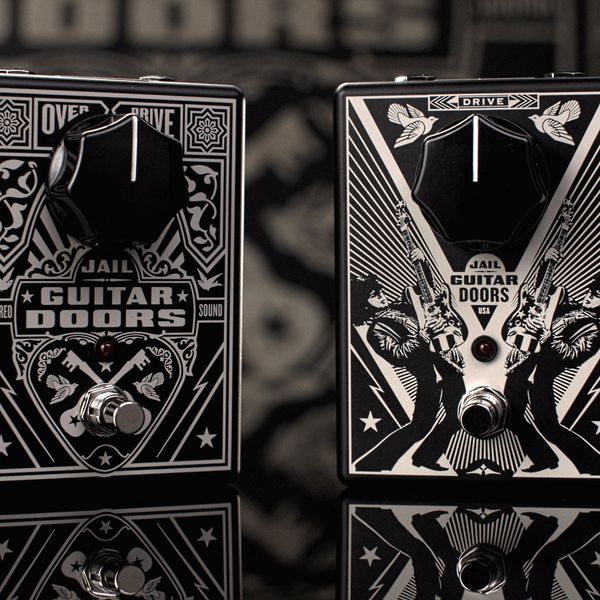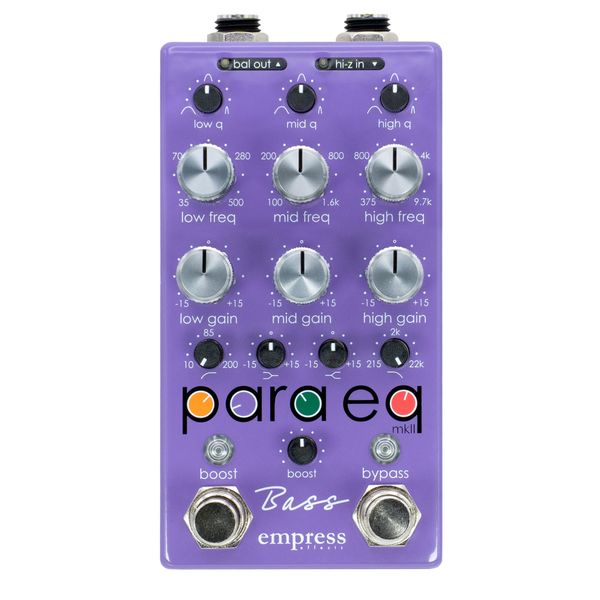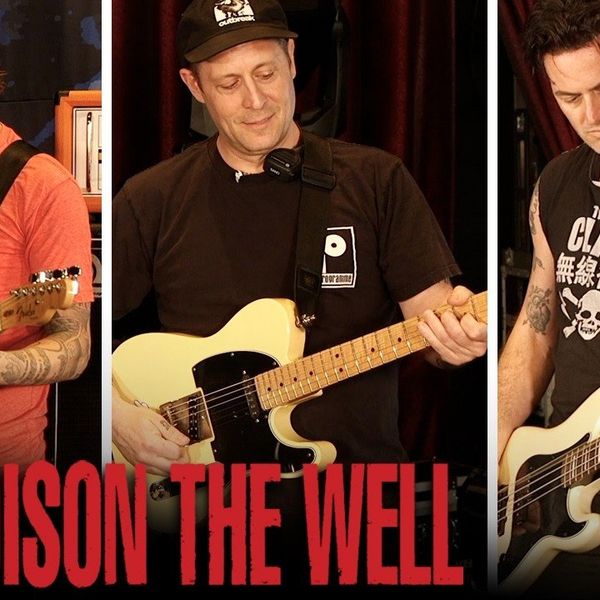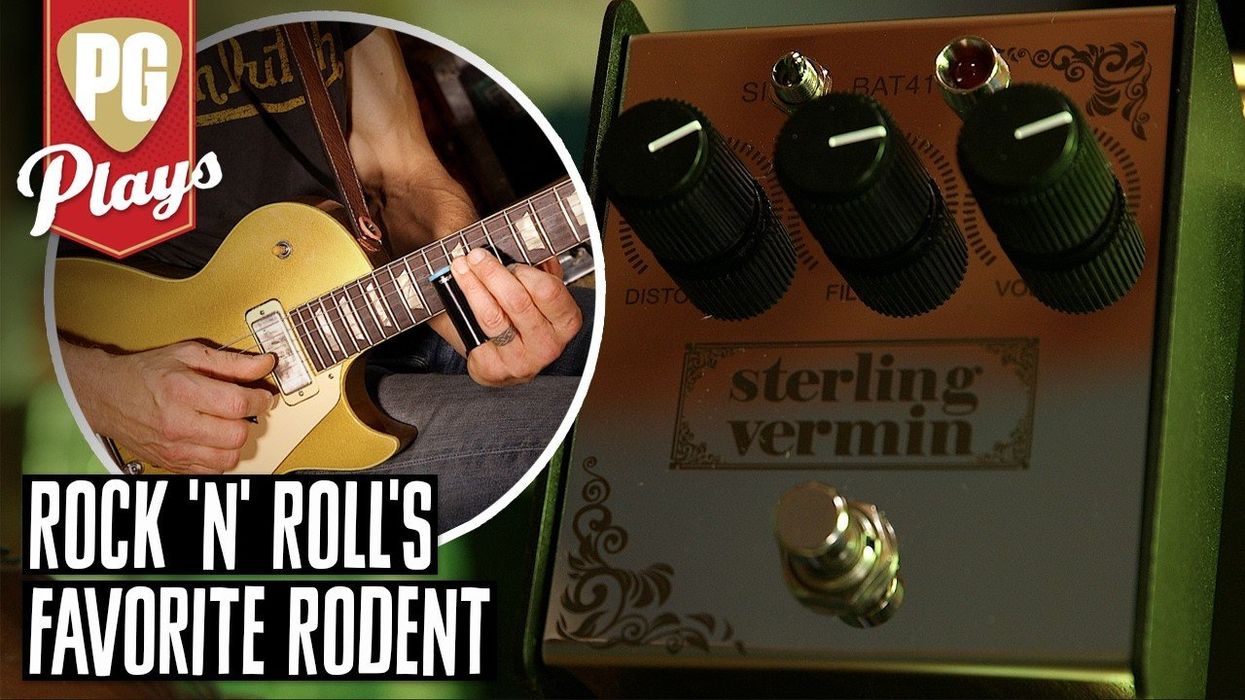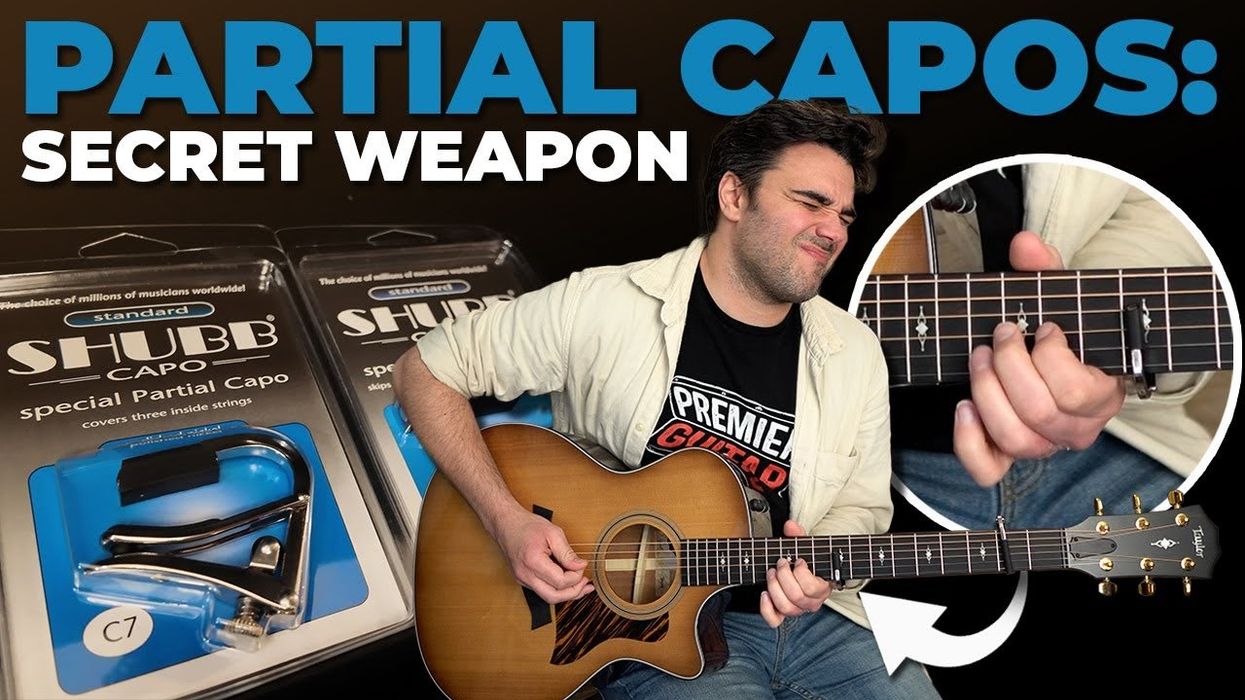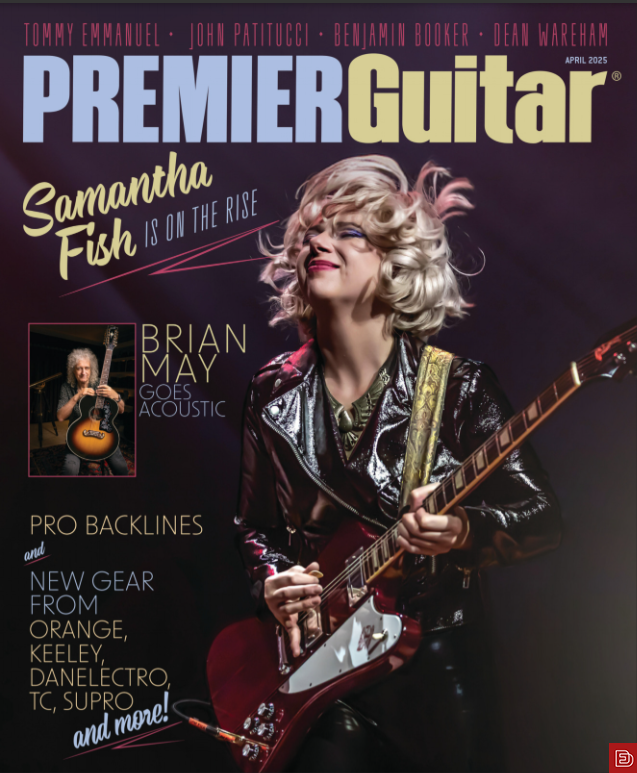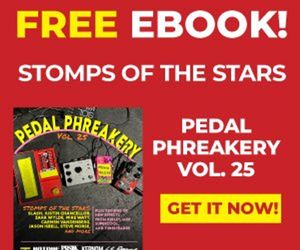
Eddie Van Halen pushed his singular talent past its limits on this overshadowed masterpiece.
Intermediate
Beginner
- Explore Eddie’s lesser-used approaches to two-hand tapping.
- Learn simple ways to create dramatic guitar parts.
- Make navigating complex time signatures a breeze.
New Adventures in Tapping
Eddie’s use of two-hand tapping is, of course, legendary. But on Fair Warning, he took it to some new places. He steered clear of the more-familiar tapping licks he used in “Eruption.” One new technique he employed on “Mean Street” is percussive tapping. Combining tapped notes and harmonics with percussive fretting-hand slaps, it’s akin to playing drums on guitar. In Ex. 1, tap the opening harmonic with the side of your picking-hand thumb, tapping right on top of the fret to make sure it clearly sounds. This is followed by some muted notes, which are sounded by lightly slapping the open strings with your fretting-hand fingers at about the third fret. Rest them on the strings as you slap to prevent them from ringing. The riff is punctuated by double-stops, in which both notes are tapped with the picking-hand index finger. Eddie often included his “Mean Street” intro during his live solo. (Note that while Eddie often tuned down a half-step, all examples here are in standard tuning.)
Eddie also had the ability to use tapping in a more melodic way, by slowing things down and substituting slides for the usual hammer-ons and pull-offs. In this way, tapping is more of a phrasing choice, meaning the melodies could be played in a more standard way using a pick, but tapping imbues them with some of Eddie’s singular style. For Ex. 2, fret the slides with your middle or ring finger, with the tapped notes played as usual. Eddie can be heard employing this version of tapping at the 3:02 mark of “Push Comes to Shove,” as part of one of his most moving guitar solos.
Creating Dramatic Riffs, Simply
For his rhythm parts, Eddie often used simple rock guitar techniques, but played them in slyly nuanced ways to created irresistibly catchy parts. Throughout Fair Warning, he bases riffs around open-string pull-offs, creating a “bouncing” effect which propels the riff along. But when playing Ex. 3, you won’t quite conjure all the magic unless you pay close attention to the accent marks in the music notation. Accents indicate when to play a note slightly louder, which on guitar translates to picking a bit harder. As much as Eddie’s playing features cool techniques, it’s also his grasp on how powerful these musical subtleties can be.
Eddie created another subtle effect by using partial chords extensively in his songwriting, an example of which being he would often drop the low root note from a standard root-fifth-octave power chord. Notice when playing Ex. 4 how this reduces the chords’ thickness, as they take up less sonic space. In a band setting, this allows them to sound with more clarity where the bass player has already got the low end covered. Now let’s explore how this gave Eddie room to add more magic.
A hallmark of the production of Fair Warning is Eddie’s frequent use of overdubbing, or layering of guitar parts, something he hadn’t yet explored extensively. But sometimes he simply creates the illusion of two guitars playing when it’s just one. Ex. 5 demonstrates how omitting the low root note can also facilitate playing two parts simultaneously with clarity. The key here is the execution of the palm-mute: Rest your picking-hand palm on the guitar’s bridge just enough to cover only the 6th and 5th strings. This way, the chords on the higher strings can ring freely. You can hear Eddie take a similar approach towards the end of “Mean Street.”
Playing Melodies with Style
Sometimes, however, adding an element can increase clarity. Throughout Fair Warning, Eddie plays more than a few memorable guitar melodies. To make them speak more clearly, and to give them a bit more character, he’ll often plays them simultaneously in two octaves. Doing this on guitar requires playing notes on two non-adjacent strings, which you can easily visualize by thinking of the standard three-string power chord shape with the middle string omitted. This is accomplished by lightly resting the inside of your fretting-hand index finger on that middle string, so it won’t be sounded by your pick. Ex. 6 illustrates how to create octaves in two different registers of the guitar, and Eddie used it to similar effect in “Unchained.”
In “Dirty Movies,” Eddie unexpectedly used a slide to inject a different sort of character into his guitar melodies. To ensure each note is solidly in tune, place the slide directly over the fret wire. Then the main challenge will be to prevent it from sounding any unused strings. Strings lower than the ones being played can be silenced with a well-placed palm mute. Then while holding your pick, allow your free picking-hand fingers to rest lightly on the underside of the higher strings not being played (Ex. 7). Note that accomplished slide players like Derek Trucks and Bonnie Raitt choose to instead play fingerstyle, producing a fuller, rounder tone than a pick. Either way, dialing back your guitar’s often-neglected tone knob a bit will help to tame any tonal shrillness.
Are Complex Time Signatures Really So Odd?
In its pre-chorus, the classic party anthem “Unchained” suddenly becomes a quasi-prog-rock adventure, featuring complex shifting time signatures. At the outset, this sort of thing can seem like a daunting challenge, but it’s really all how you think about it. Ex. 7 features time signatures of 6/4 and 7/4. How can we navigate these measures without pulling our hair out? Well, often these complex time signatures can be broken down into a combination of simpler ones we use every day. Let’s look at measure one, which is in 6/4. If we think of this as simply 4/4 plus 2/4, it’s more manageable. In much the same way, measure two’s 7/4 can be broken down into 4/4 plus 3/4.
While the final two songs of Fair Warning are arguably also-rans, I still can’t escape the notion that if I could only listen to one Van Halen album for the rest of time, it would be this one. Eddie’s playing seems almost supernatural, and the breadth of his creativity makes Fair Warning a triumph, album sales be damned.
-
Crank the heat! PG's John Bohlinger plugs into the boutique-built Sterling Vermin, a modern twist on the iconic Rat distortion. Hear it rip through Strats, Teles, and a Les Paul with classic snarl and smooth silicon/BAT41 clipping.
Sterling Vermin RAT
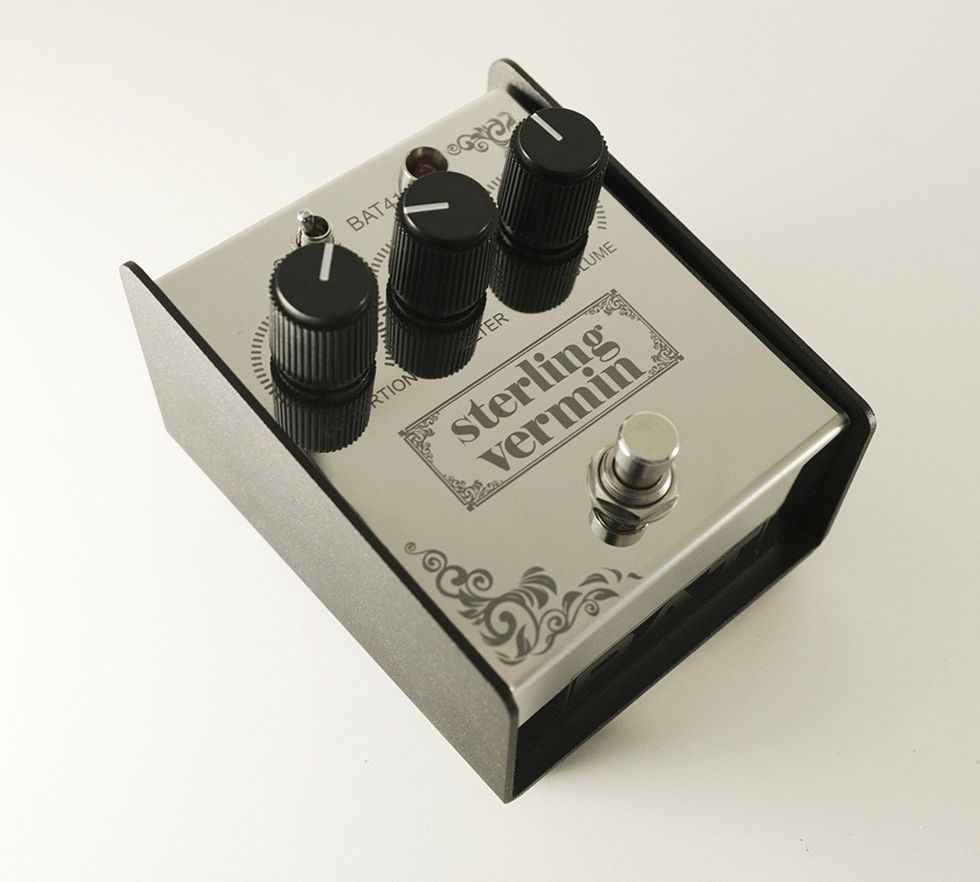
The Sterling Vermin was born from a desire for something different — something refined, with the soul of a traditional RAT pedal, but with a voice all its own.
Built in small batches and hand-soldered in ACT’s Jackson, Missouri headquarters, the Sterling Vermin is a work of pure beauty that honors the brand legacy while taking a bold step forward for creativity.
The Sterling Vermin features the LM741 Op-Amp and a pair of selectable clipping diodes. Players can toggle between the traditional RAT silicon diode configuration for a punchy, mid-range bite, or the BAT41 option for a smoother, more balanced response. The result is a pedal that’s equally at home delivering snarling distortion or articulate, low-gain overdrive, with a wide, usable tonal range throughout the entire gain spectrum.
The pedal also features CTS pots and oversized knobs for even, responsive control that affords a satisfying smoothness to the rotation, with just the right amount of tension. Additionally, the polished stainless-steel enclosure with laser-annealed graphics showcases the merging of the pedal’s vintage flavor and striking design.
From low-gain tones reminiscent of a Klon or Bluesbreaker, to high-gain settings that flirt with Big Muff territory — yet stay tight and controlled — the Sterling Vermin is a masterclass in dynamic distortion. With premium components, deliberate design and a focus on feel, the Sterling Vermin is more than a pedal, it’s a new chapter for RAT.
The Sunset is a fully analog, zero latency bass amplifier simulator. It features a ¼” input, XLR and ¼” outputs, gain and volume controls and extensive equalization. It’s intended to replace your bass amp both live and in the studio.
If you need a full sounding amp simulator with a lot of EQ, the Sunset is for you. It features a five band equalizer with Treble, Bass, Parametric Midrange (with frequency and level controls), Resonance (for ultra lows), and Presence (for ultra highs). All are carefully tuned for bass guitar. But don’t let that hold you back if you’re a keyboard player. Pianos and synthesizers sound great with the Sunset!
The Sunset includes Gain and master Volume controls which allow you to add compression and classic tube amp growl. It has both ¼” phone and balanced XLR outputs - which lets you use it as a high quality active direct box. Finally, the Sunset features zero latency all analog circuitry – important for the instrument most responsible for the band’s groove.
Introducing the Sunset Bass Amp Simulator
- Zero Latency bass amp simulator.
- Go direct into the PA or DAW.
- Five Band EQ:
- Treble and Bass controls.
- Parametric midrange with level and frequency controls.
- Presence control for extreme highs.
- Resonance control for extreme lows.
- Gain control to add compression and harmonics.
- Master Volume.
- XLR and 1/4" outputs.
- Full bypass.
- 9VDC, 200mA.
Artwork by Aaron Cheney
MAP price: $210 USD ($299 CAD).
PG contributor Tom Butwin reveals his favorite songwriting secret weapon: the partial capo. Watch how the Shubb C7 and C8 can simulate alternate tunings without retuning your guitar—and spark fresh creative ideas instantly.
Shubb C8b Partial Capo for Drop-D Tuning - Brass
The C8 covers five of the six strings, leaving either the low E or high E string open, depending on how it's positioned.
- Standard setup: Placed on the 2nd fret while leaving the low E string open, it simulates Drop D-style sounds—except you're still in standard tuning (key of E). You get that big, droning bass feel without retuning.
- Reverse setup: Flipping the capo allows the high E string to ring, giving you shimmering drones and new melodic options across familiar chord shapes.
- A flexible tool that lets you simulate alternate tunings and create rich sonic textures—all while keeping your guitar in standard tuning.
Shubb C7b Partial Capo for DADGAD Tuning - Brass
The C7 covers three of the six strings—either D, G, and B or A, D, and G—depending on how it's flipped.
- Typical setup (D, G, B): Creates an open A chord shape at the 2nd fret without needing your fingers. This frees you up for new voicings and droning notes in the key of A.
- Reversed setup (A, D, G): Gets you close to a DADGAD-style tuning vibe, but still keeps you in standard tuning—great for modal, spacious textures often found in folk or cinematic guitar parts.
Use it alone or stack it with the C8 for wild, layered effects and truly out-of-the-box inspiration.
PRS Guitars celebrates 40 years with the limited edition McCarty SC56. Featuring vintage-inspired design and modern innovations, this single-cutaway guitar pays tribute to Ted McCarty and his impact on the industry. With only 400 pieces available, this instrument is a must-have for collectors and performers alike.
PRS Guitars today announced the 40th Anniversary McCarty SC56 Limited Edition. With a classic PRS single-cutaway body shape and carefully chosen specifications, the McCarty SC56 is both a tribute to tradition and a reliable tool for the modern performer. Only 400 pieces will be made.
“The SC56, signifying Singlecut and 1956, model is our most recent tribute to my late mentor Ted McCarty and his impact on the guitar industry. We started with our take on a classic late ‘50s singlecut body. 1956 marks the year that Ted first had guitars made with his newly coined 'humbucker' pickups. It also happens to be the year I was born. Bringing vintage design into the modern era, we loaded this model with our McCarty III pickups, meticulously designed to deliver warm, clear, vintage tone with exceptional note separation and dynamics,” said PRS Guitars Founder & Managing General Partner, Paul Reed Smith.
Anchored by a maple top and mahogany back, the 24.594” scale length and 22-fret Pattern Vintage neck work with Phase III non-locking tuners and PRS two-piece bridge to promote its musical sustain. The PRS McCarty III pickups are controlled by a simple layout — two volume controls, two tone controls, and a three-way toggle on the upper bout.
Single-cutaway guitars are known to be heavier than their double-cutaway counterparts. The McCarty SC56 Limited Edition design incorporates weight-relief, decreasing the weight of the guitar by about 2/3 of a pound, while maintaining several points of attachment between the guitar top and back to eliminate the “hollow” sound of the cavities and promote tone transfer.
With appointments like binding on the fretboard, classic bird inlays, and a vintage-inspired nitrocellulose finish, the 40th Anniversary McCarty SC56 Limited Edition blends heritage and innovation into a timeless instrument.
PRS Guitars continues its schedule of launching new products each month in 2025.
For more information, please visit prsguitars.com.
